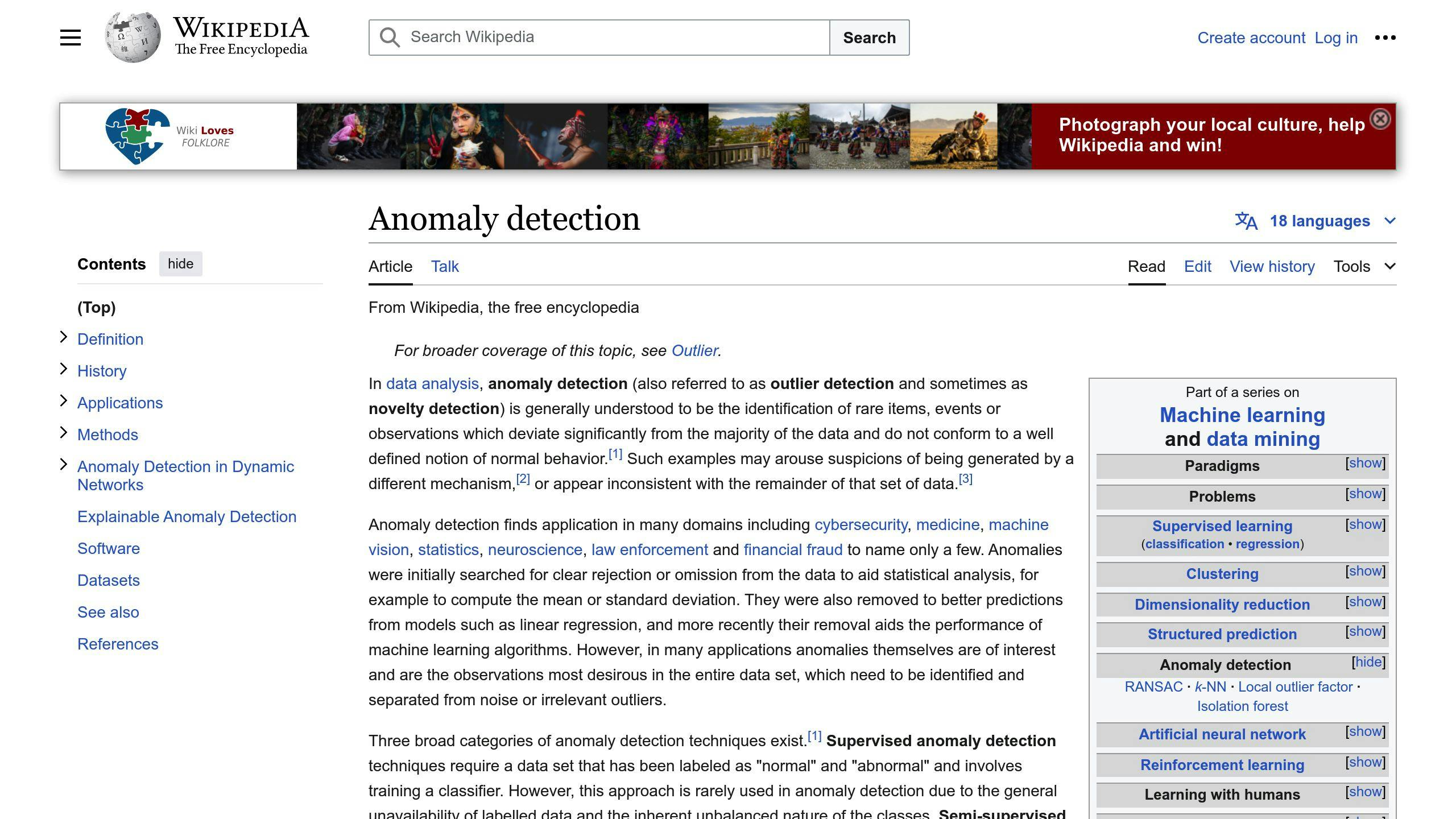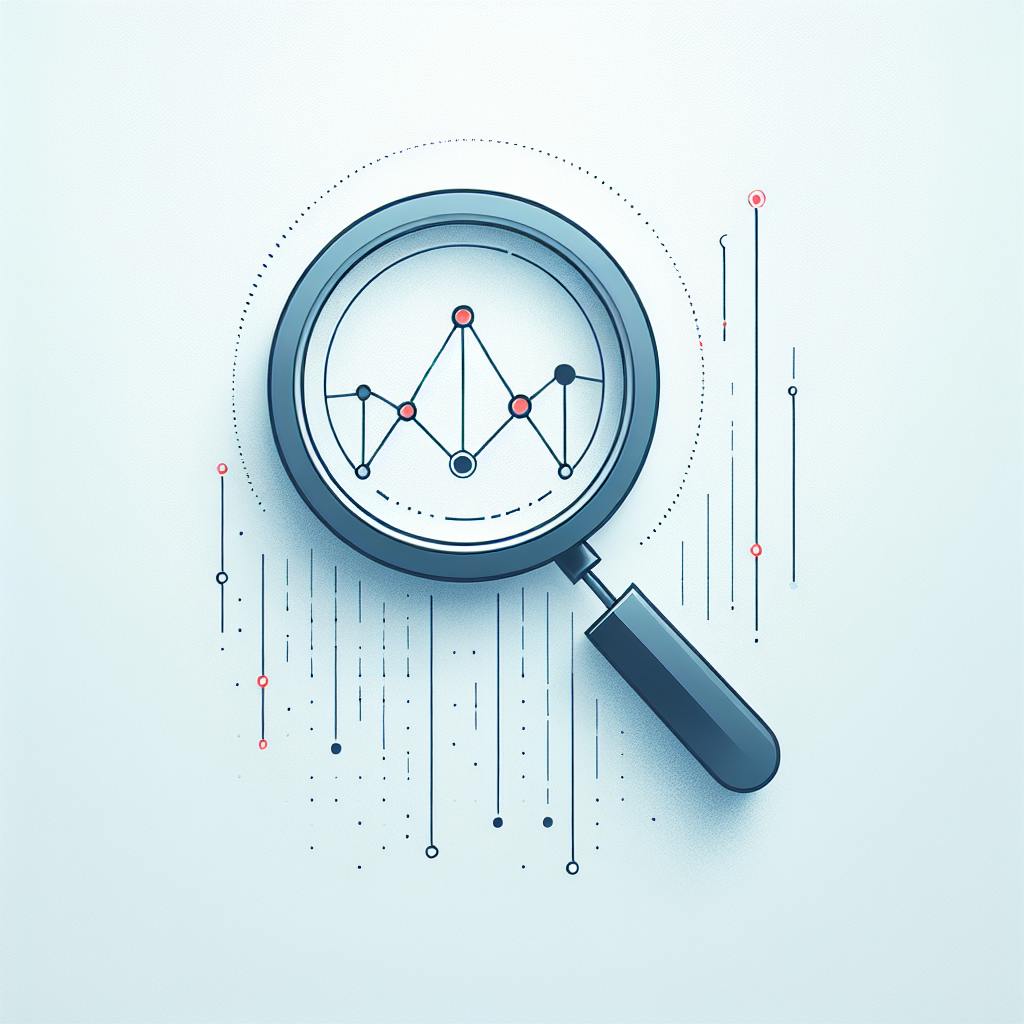Machine Learning (ML) anomaly detection is a critical technology that helps identify unusual data patterns, which can indicate issues such as cyberattacks, fraud, or system failures. Here's a quick overview of what you need to know:
- Anomaly Types: Point anomalies (single data points), contextual anomalies (data points odd in specific contexts), and collective anomalies (groups of data points).
- Key ML Algorithms: Isolation Forest, Local Outlier Factor (LOF), One-Class SVM, K-Nearest Neighbors (KNN), and Neural Networks, each with its own strengths and weaknesses.
- Implementation Steps: Data preparation, choosing the right algorithm, training the model, and evaluating performance.
- Use Cases: Cybersecurity, fraud detection, infrastructure monitoring, manufacturing, and healthcare.
- Tools and Software: IBM Instana, AWS SageMaker, and open-source libraries like PyOD and Scikit-learn.
This guide delves into the essentials of ML anomaly detection, from understanding anomalies and the algorithms used to detect them, to implementing solutions and exploring real-world applications across various industries.
Definition and Types
An anomaly can be one of three main types:
Point Anomalies
Think of this as a single piece of data that sticks out because it's very different from the usual.
Example: A credit card charge that's way higher than what's normal for the account.
Contextual Anomalies
This is when a piece of data only looks weird in certain situations, like at a specific time.
Example: A website getting a lot of visits at 3 AM.
Collective Anomalies
When a bunch of data points together look strange compared to the rest.
Example: Many users logging in from odd locations all at once.
Why Anomalies Occur
Here are some common reasons why these odd bits show up:
- Data errors: Mistakes in how data is collected or entered can make anomalies. This includes typos or files not uploading completely.
- Noise: Random errors in measurements can also lead to odd data points.
- Attacks: Cyberattacks, like DDoS attacks, aim to mess up systems by causing abnormal behavior.
- Fraud: Tricks like identity theft or fake transactions create anomalies. An example is suddenly moving a lot of money.
Finding these anomalies early is key to fixing issues before they turn into big problems. Looking more into these odd bits helps figure out the best way to deal with them.
Fundamentals of Machine Learning for Anomaly Detection

Machine Learning Overview
Machine learning is like teaching a computer to spot what doesn't belong in a bunch of data, without having to tell it exactly what to look for every time. Here's a quick rundown:
- It works by feeding the computer examples and letting it figure out patterns. Once it knows the patterns, it can spot when something doesn't match up.
- Some tools it uses include things like random forest and neural networks. These are just fancy ways of sorting data and finding the odd ones out.
- This tech is great because it can handle a ton of information and find the tiny details that might not be obvious to people.
- Once it's all set up, machine learning can quickly go through lots of data to point out possible problems.
- But, just because the computer says something is off, doesn't always mean it's a big deal. Sometimes it's just a mistake or something minor. It's important to check the computer's work.
In short, machine learning makes it easier and faster to find data that sticks out for the wrong reasons, helping catch issues early on.
Supervised vs. Unsupervised vs. Semi-supervised
When it comes to training computers to spot anomalies, there are three main ways:
Supervised Learning
- Here, the computer learns from data that's already been sorted into 'normal' and 'not normal.'
- This way, it gets really good at knowing what to look out for.
- The downside is you need a lot of pre-sorted data to start with.
Unsupervised Learning
- In this method, the computer tries to figure things out on its own from unsorted data.
- It learns what's normal and flags anything that doesn't fit.
- The good part is, you don't need to sort the data first.
Semi-Supervised Learning
- This is a mix of the first two. The computer learns from some data that's sorted and some that isn't.
- It's a good middle ground, but you still need to do some sorting.
Choosing the right method depends on what kind of data you have and what you're looking for. Often, a mix of methods works best to make sure nothing slips through the cracks.
Key Machine Learning Algorithms for Anomaly Detection
Isolation Forest
Think of the isolation forest method as playing a game of 'spot the difference' with data. It tries to find the odd data points by splitting the data into smaller groups until each point stands alone. The fewer steps it takes to isolate a data point, the more likely it is an anomaly. It's great for big datasets and doesn't need a lot of data to start with. However, it might not catch the very tiny odd details and can be a bit heavy on the computer for very large sets of data.
Local Outlier Factor (LOF)
LOF is like looking at how crowded a party is and spotting who's standing too far away from any group. It checks how dense the data is around each point. If a point is in a much less crowded area, it's flagged as an anomaly. This method is good at finding outliers but can be slow if you have a lot of data and needs some fine-tuning to get right.
One-Class SVM
One-Class SVM is about drawing an imaginary line around normal data. Points outside this line are seen as anomalies. It's useful when you don't have a lot of examples to learn from. However, it's not great for big datasets, and picking the right settings can be tricky.
K-Nearest Neighbors (KNN)
KNN works by measuring distances. It looks at each data point and its nearest neighbors. If a point is far away from its neighbors, it's considered an odd one out. This method is straightforward and works well for spotting local anomalies. But, it can slow down with more data and doesn't like it when data has many dimensions.
Neural Networks
Neural networks are like teaching a computer to recognize what's normal and what's not by showing it examples. They're good at finding complicated patterns and can learn as data changes. However, they can make mistakes if they don't have enough examples to learn from and need a lot of computer power to train.
Comparison of Algorithms
| Algorithm | Key Strengths | Limitations |
|---|---|---|
| Isolation Forest | Good with big, complex data. Fast. | Might miss tiny anomalies. Complex. |
| LOF | Good at finding outliers. | Slow with lots of data. Needs fine-tuning. |
| One-Class SVM | Works with few examples. Customizable. | Not great for big data. Hard to set up right. |
| KNN | Simple. Good for local anomalies. | Slows down with more data. Doesn't like many dimensions. |
| Neural Nets | Finds complex patterns. Learns over time. | Can overfit. Needs lots of computer power. |
Implementing ML Anomaly Detection: A Step-by-Step Guide
Data Collection and Preparation
Getting started with ML anomaly detection means gathering and setting up your data first. Here's what you need to do:
- Identify data sources: Figure out where your data is coming from. This could be your computer networks, apps, or any system you want to keep an eye on.
- Collect baseline data: Grab data from the last 2-4 weeks when everything was running smoothly. This helps you understand what 'normal' looks like.
- Clean and transform data: Fix any mistakes in your data, get rid of unnecessary info, fill in missing parts, and change it into a format that the computer algorithms can work with.
- Split into train/test sets: Save some of this 'normal' data for testing how well your model works later. Use the rest for training.
Getting your data ready is super important so that the ML algorithms can correctly learn what's normal and what's not.
Choosing the Right Algorithm
With so many algorithms out there, you need to think about a few things to pick the right one:
- Data type: What kind of data are you dealing with? Some algorithms are better for specific types of data.
- Speed: If you need quick results, go for faster options like Isolation Forest or KNN. If it's okay to wait, Neural Networks might work.
- Accuracy: Look at how precise the algorithm is by checking its precision, recall, and F1 scores with your data.
- Interpretability: Some algorithms, like LOF, make it easier to understand why something was flagged as odd.
- Data scale: For larger sets of data, you might need algorithms designed for big data.
Trying a few different algorithms on your data is a good idea to see which one fits best.
Training the Model
After picking your algorithm, you'll need to:
- Choose hyperparameters: Adjust settings that help control how the model learns.
- Validation: Check how well the model does with a set of data it hasn't seen before.
- Update training data: Keep adding new 'normal' data and retrain your model regularly.
This process helps make sure your model can accurately identify new, unseen data.
Evaluating Model Performance
Once your model is up and running, keep an eye on:
- Precision: How many of the flagged anomalies were actually problems.
- Recall: How many of the real issues were caught.
- F1 score: A balance between precision and recall.
These metrics help you understand how well your model is doing in the real world. If you notice the performance dropping, it might be time to retrain your model.
Use Cases Across Industries
Anomaly detection is a big deal in many different areas of work. It helps organizations find problems early and fix them. Let's look at some important ways it's used.
Cybersecurity
In the world of online security, spotting weird behavior is key. Anomaly detection helps find signs of possible cyber attacks. Here are some examples:
- Network intrusion detection - This means finding unusual patterns in network traffic that could point to things like DDoS attacks.
- Insider threat monitoring - This is about catching when someone inside the organization accesses or moves data they shouldn't.
- User behavior analysis - This helps notice when a user's actions don't match their usual pattern, which might mean their account is at risk.
Tools like the isolation forest algorithm and deep learning help catch new kinds of cyber threats.
Fraud Detection
Banks, online shops, and insurance companies use anomaly detection to spot fake transactions. Here's how:
- Credit card fraud - This involves catching strange spending patterns, like buying a lot in a place far from home.
- Healthcare fraud - This is about finding false or too high insurance claims.
- Account takeover - This means noticing when someone logs in from a strange place or at an odd time.
Models that learn from examples of good and bad transactions are really good at finding fraud.
Infrastructure Monitoring
Anomaly detection is great for keeping an eye on important tech stuff like servers and networks. Here's what it does:
- Network performance monitoring - It sends alerts about slow internet or too much traffic.
- Predictive maintenance - It finds signs that equipment might break down soon.
- SLA violation monitoring - It keeps track of things like how often a service is down or how fast it works.
Using methods that don't need examples of problems to learn from is helpful for predicting when things might break.
Manufacturing
In making things, finding faults in products or processes is crucial. Here's where anomaly detection comes in:
- Structural defect detection - This uses computer vision to find flaws in products.
- Sensor-based monitoring - This catches weird readings from machines.
- Predictive maintenance - This uses data from machines and sensors to guess when they might fail.
Using smart tools and data from machines, factories can spot problems before they get worse.
Healthcare
In healthcare, finding odd symptoms or test results can help doctors make better decisions. Here are some uses:
- Disease detection - This finds unusual symptoms that might mean a bigger health issue.
- Medical records analysis - This looks for strange test results that need more checking.
- Genomics research - This spots odd gene patterns that could lead to new discoveries.
Healthcare offers many chances to use different kinds of anomaly detection to improve patient care.
sbb-itb-9890dba
Tools and Software for Anomaly Detection
IBM Instana
IBM Instana is a tool that helps you keep an eye on how well your apps and tech stuff are working. It uses smart learning to quickly spot when something's not right. Here's what it can do:
- Watches important numbers like how fast your app responds, how much it's used, and when errors happen
- Learns what's normal to better spot when things go off track
- Uses smart alerts to point out problems
- Helps figure out why issues happened
- Connects easily with other monitoring tools
It's really good for apps that use modern cloud and microservices but doesn't let you make your own smart models.
AWS SageMaker
Amazon SageMaker is a tool from Amazon that helps you build, use, and manage smart learning models. It's great for finding issues in real-time and works well with data from Amazon Kinesis and CloudWatch. You can also:
- Use notebooks to create your own models with special algorithms
- Easily get your models out there for people to use
- Works well with Amazon's data handling and storage services
SageMaker is powerful for making and handling your own models but you need to know a bit about cloud tech to use it.
Open Source Libraries
There are free tools like PyOD, PyCaret, and Scikit-learn that give you what you need to spot anomalies:
- PyOD: Has a bunch of models for finding odd data points
- PyCaret: Helps with models like isolation forest and elliptical envelope
- Scikit-learn: A go-to for learning models with options for unsupervised data processing
These tools are great if you want to build custom models but you'll need to know how to turn these models into real-world solutions.
Eyer.ai Platform
Eyer.ai is all about spotting when data doesn't look right, especially over time:
- Sends alerts without crying wolf
- Tools to dig into what caused the issue
- Lets you adjust settings to ignore minor issues
- Easy to connect with your data sources
- Clear dashboards to see what's going wrong
It's designed to make it easier to watch over complex systems but doesn't let you tweak the smart models much.
Comparative Analysis
| Tool/Platform | Use Cases | Key Capabilities | Limitations |
|---|---|---|---|
| IBM Instana | Watching cloud apps | Learns and alerts on its own | Can't make custom models |
| AWS SageMaker | Building your own models | Full package for model development | Needs cloud know-how |
| Open Source Libraries | Making prototypes | Flexible but technical | No monitoring included |
| Eyer.ai | Keeping an eye on data | Quick setup and smart alerts | Limited model tweaking |
Each tool offers a unique way to help with finding anomalies, with their own strengths and areas where they might not be the best fit.
Challenges and Solutions in ML Anomaly Detection
Key Challenges
When using machine learning to find odd bits in data, teams run into a few common problems:
- Imbalanced datasets: Usually, there's a lot more normal data than weird data. This can make the models biased, thinking most things are normal.
- Concept drift: What's considered normal can change over time. This means models might start getting things wrong unless they're updated.
- Poor data quality: Problems like mistakes in the data or missing information can mess up how well the models work. Cleaning up the data is crucial.
- Difficulty labeling: Sometimes it's hard to tell if something is really an oddity. Getting good data that's clearly marked is tough.
- High false positive rates: If the model is too sensitive, it might alert too often, wasting time. Adjusting the models and their settings can help.
- Scaling difficulties: Handling and analyzing a lot of data, especially over time, can be hard.
Recommendations and Best Practices
Here are some tips to deal with these challenges:
- Use resampling techniques like SMOTE to make the training data more balanced.
- Continuously retrain models with new data to keep up with changes. Doing this regularly helps.
- Invest in data cleaning by using methods to fix, fill in, or adjust data.
- Leverage semi-supervised learning to use both labeled and unlabeled data effectively.
- Optimize thresholds carefully, and keep an eye on metrics like precision and recall to reduce false alerts.
- Employ distributed computing frameworks like Apache Spark to handle big data more easily.
Other good practices include testing models with different datasets, watching how well they're doing, and adjusting settings to make them better over time.
The Future of Anomaly Detection
As machine learning gets better, spotting unusual data or activities is going to become even more effective. Let's look at some cool developments that might change how we find things that don't fit in:
Neuro-Symbolic AI
Neural networks are really good at noticing patterns, but they can be like black boxes - it's hard to tell how they make decisions. Combining them with symbolic AI, which uses clear rules and logic, could make anomaly detection not only smarter but also easier to understand.
This mix could help us get why a piece of data was marked as strange. Having rules could also make these systems more reliable.
Generative Adversarial Networks
GANs involve two neural networks challenging each other to create new, realistic-looking data. This can help make better training sets, especially when we don't have enough examples of anomalies.
GANs could also test systems by coming up with tricky data that helps make our models even stronger.
Reinforcement Learning
RL teaches models to learn from their actions to get better results. This could help anomaly detection systems automatically adjust themselves to avoid too many false alarms.
RL might also make it easier to train systems, like neural networks, to spot odd things more accurately over time.
Increasing Use of Unsupervised Learning
As we get more data without labels, learning without clear examples (unsupervised learning) will probably become more common. This means we won't get stuck just because we don't have everything sorted out from the start.
This type of learning is good at dealing with changes, which means it can catch new kinds of oddities better.
Tighter Integration With Monitoring Tools
If anomaly detection is built right into the tools that monitor our systems, it can give us a clearer picture of what's going on. This might help cut down on mistakes and find the real problems faster.
With this setup, spotting something odd could automatically trigger helpful actions, like balancing the workload or starting a fix.
Cloud-Native Implementations
As cloud tech gets better, anomaly detection will likely move more towards using the cloud. This means easier scaling, lower costs for equipment, and paying only for what you use.
Cloud-based setups make it simpler to handle big data and can adapt quickly as needs change.
With all these advancements, spotting anomalies is set to get smarter, more reliable, and easier to manage. This will open up new possibilities and make it an even more important tool in many fields.
Conclusion
Summary of Key Points
Anomaly detection helps us spot problems in data before they get big. This guide walked us through how machine learning helps with that:
- Anomaly types: We talked about different kinds of odd data bits - point, contextual, and collective - which come from mistakes, noise, cyberattacks, fraud, and more. Catching these early stops bigger issues from happening.
- Algorithms: We looked at different methods like Isolation Forest, LOF, One-Class SVM, KNN, and Neural Networks. Each has its strengths and weaknesses, and the best one for you depends on what you're trying to do and the kind of data you have.
- Process: We learned that doing things the right way from the start - like preparing data, building and checking your model, and keeping it up to date - helps make sure it works well.
- Use cases: From keeping computer networks safe to spotting fake transactions and keeping an eye on health data, machine learning for spotting anomalies is super useful in many areas.
- Tools: We talked about different tools you can use, like IBM Instana, AWS SageMaker, and free software libraries. Each one offers something different.
With more data and more risks out there, machine learning is becoming a must-have for spotting problems early in all kinds of industries. If you follow a careful approach, it can really help with prevention and quick action.



